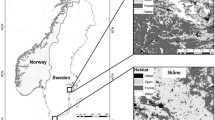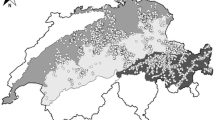Abstract
The population of red deer (Cervus elaphus) has increased substantially in many western European countries during recent decades. Simultaneously, agricultural practices have undergone major changes. Observations suggest that meadows and pastures are important sources of nutrients for deer, but there are few studies quantifying the selection of agricultural land by deer in general. Here, we study red deer selection of various types of agricultural land and the history of land use (times of fertilisation and since renewal) in Norway. We used data from 14 female and 12 male red deer with GPS collars during the years 2007–2010. Our study design was to compare pairs of agricultural fields that had received “low” and “high” use by a given individual red deer and data were analysed by using case–control logistic regression. Our results showed that both sexes selected meadows over other types of agricultural land. Females selected intensively fertilised meadows and meadows of intermediate age, while male selection did not depend on meadow age (time since renewal) or fertilisation. The smaller females thus selected meadows of high quality, while the larger males continued to use old meadows of lower quality but rich in biomass. Our analysis suggests that a decreasing supply of meadows in the future due to lower production of livestock fodder may also affect management of red deer, and that a future change in the intensity of agricultural practices may affect sexes of wild large herbivores differently.




Similar content being viewed by others
References
Abbas F, Merlet J, Morellet N, Verheyden H, Hewison AJM, Cargnelutti B, Angibault JM, Picot D, Rames JL, Lourtet B, Aulagnier S, Daufresne M (2012) Roe deer may markedly alter forest nitrogen and phosphorus budgets across Europe. Oikos 121:1271–1278
Albon SD, Langvatn R (1992) Plant phenology and the benefits of migration in a temperate ungulate. Oikos 65:502–513
Ammar H, López S, González JS, Ranilla MJ (2004) Chemical composition and in vitro digestibility of some Spanish browse plant species. J Sci Food Agr 84(2):197–204
Apollonio M, Andersen R, Putman R (2010) European ungulates and their management in the 21st century. Cambridge University Press, New York
Bakken A, Lunnan T, Høglind M (2008) Quality development in regrowths of timothy, meadow fescue and red clover. In: Hopkins A, Gustafsson T, Bertilsson J, Dalin G, Nilsdotter-Linde N, Spörndly E (eds). Biodiversity and animal feed future challenges for grassland production. 22nd General Meeting of the European Grassland Federation, Uppsala, Sweden, 9–12 June 2008. Grassland Science in Europe. pp 444–446
Bakker JP, Berendse F (1999) Constraints in the restoration of ecological diversity in grassland and heathland communities. Trends Ecol Evol 14(2):63–68
Balmford A, Green R, Phalan B (2012) What conservationists need to know about farming. Proc R Soc Lond Ser B 279:2714–2724
Bell RHV (1971) A grazing ecosystem in the Serengeti. Sci Am 225:86–89
Bischof R, Loe L, Meisingset E, Zimmermann B, Van Moorter B, Mysterud A (2012) A migratory northern ungulate in the pursuit of spring: jumping or surfing the green wave? Am Nat 180(4):407–424
Bonenfant C, Loe LE, Mysterud A, Langvatn R, Stenseth NC, Gaillard JM, Klein F (2004) Multiple causes of sexual segregation in European red deer: enlightenments from varying breeding phenology at high and low latitude. Proc R Soc Lond Ser B 271:883–892
Brook RK (2010) Habitat selection by parturient elk (Cervus elaphus) in agricultural and forested landscapes. Can J Zoo 88(10):968–976
Clutton-Brock TH, Guinness FE, Albon SD (1982) Red deer. Behaviour and ecology of two sexes. Edinburgh University Press, Edinburgh
Cramer VA, Hobbs RJ, Standish RJ (2008) What's new about old fields? Land abandonment and ecosystem assembly. Trends Ecol Evol 23(2):104–112
Ferron ES, Verheyden H, Hummel J, Cargnelutti B, Lourtet B, Merlet J, González-Candela M, Angibault JM, Hewison AJM, Clauss M (2012) Digestive plasticity as a response to woodland fragmentation in roe deer. Ecol Res 27:77–82
Godvik IMR, Loe LE, Vik JO, Veiberg V, Langvatn R, Mysterud A (2009) Temporal scales, trade-offs, and functional responses in red deer habitat selection. Ecology 90(3):699–710
Gottschalk TK, Diekötter T, Ekschmitt K, Weinmann B, Kuhlmann F, Purtauf T, Dauber J, Wolters V (2007) Impact of agricultural subsidies on biodiversity at the landscape level. Landsc Ecol 22:643–656
Heaton E, Voigt T, Long SP (2004) A quantitative review comparing the yields of two candidate C4 perennial biomass crops in relation to nitrogen, temperature and water. Biomass Bioenergy 27(1):21–30
Hebblewhite M, Merrill E, McDermid G (2008) A Multi-scale test of forage maturation hypothesis in a partially migratory ungulate population. Ecol Monogr 78(2):141–166
Hosmer DW, Lemeshow S (2000) Applied logistic regression. Wiley, New York
Hurley PM, Webster CR, Flaspohler DJ, Parker GR (2012) Untangling the landscape of deer overabundance: reserve size versus landscape context in the agricultural Midwest. Biol Conservat 146(1):62–71. doi:10.1016/j.biocon.2011.10.034
Jarman PJ (1974) The social organisation of antelope in relation to their ecology. Behavior 48:215–266
Langvatn R, Hanley TA (1993) Feeding-patch choice by red deer in relation to foraging efficiency—an experiment. Oecologia 95(2):164–170
Liu J, Dietz T, Carpenter SR, Alberti M, Folke C, Moran E, Pell AN, Deadman P, Kratz T, Lubchenco J, Ostrom E, Ouyang Z, Provencher W, Redman CL, Schneider SH, Taylor WW (2007) Complexity of coupled human and natural systems. Science 317:1513–1516
Loe LE, Bonenfant C, Meisingset E, Mysterud A (2012) Effects of spatial scale and sample size in GPS-based species distribution models: are the best models trivial for red deer management? Eur J Wildl Res 58:195–203
Macdonald DW, Tattersall FH, Service KM, Firbank LG, Feber RE (2007) Mammals, agri-environment schemes and set-aside—what are the putative benefits? Mamm Rev 37(4):259–277
Meisingset EL, Loe LE, Brekkum Ø, Van Moorter B, Mysterud A (2013) Red deer habitat selection and movements in relation to roads. J Wildl Manag 77:181–191
Middleton AD, Kauffman MJ, McWhirter DE, Cook JG, Cook RC, Nelson AA, Jimenez MD, Klaver RW (2013) Animal migration amid shifting patterns of phenology and predation: lessons from a Yellowsone elk herd. Ecology 94:1245–1256
Milner JM, Bonenfant C, Mysterud A, Gaillard JM, Csanyi S, Stenseth NC (2006) Temporal and spatial development of red deer harvesting in Europe: biological and cultural factors. J Appl Ecol 43(4):721–734
Mysterud A, Yoccoz NG, Stenseth NC, Langvatn R (2000) Relationships between sex ratio, climate and density in red deer: the importance of spatial scale. J Anim Ecol 69(6):959–974
Mysterud A, Langvatn R, Yoccoz NG, Stenseth NC (2002) Large-scale habitat variability, delayed density effects and red deer populations in Norway. J Anim Ecol 71(4):569–580
Mysterud A, Meisingset E, Veiberg V, Langvatn R, Solberg EJ, Loe LE, Stenseth NC (2007) Monitoring population size of red deer Cervus elaphus: an evaluation of two types of census data from Norway. Wildlife Biol 13(3):285–298
Mysterud A, Loe LE, Zimmermann B, Bischof R, Veiberg V, Meisingset E (2011) Partial migration in expanding red deer populations at northern latitudes—a role for density dependence? Oikos 120:1817–1825
Mysterud A (2013) Ungulate migration, plant phenology, and large carnivores: the times they are a-changin'. Ecology 94:1257–1261
R Development Core Team (2011) R: a language and environment for statistical computing. R Foundation for Statistical Computing, Vienna, Austria. ISBN 3-900051-07-0. http://www.r-project.org/
Ruckstuhl KE, Neuhaus P (2005) Sexual segregation in vertebrates. Ecology of the two sexes. Cambridge University Press, Cambridge
Scott D, Palmer SF (2000) Damage by deer to agriculture and forestry. Report to Deer Commission for Scotland. Institute of Terrestrial Ecology, Banchory Research Station
Statistics Norway (2011) Gjennomsnitllig næringsinntekt fra jordbruk for brukere, etter driftsform og fylke. Available at: http://www.ssb.no/binfo/tab-2011-03-14-07.html. Accessed 21 Feb 2012 (in Norwegian)
Therneau T (2012) A package for survival analysis in S. R Packag Version 2:36–12
Thomas DL, Taylor EJ (1990) Study designs and tests for comparing resource use and availability. J Wildl Manag 54(2):322–330. doi:10.2307/3809050
Thomas DL, Taylor EJ (2006) Study designs and tests for comparing resource use and availability II. J Wildl Manag 70(2):324–336. doi:10.2193/0022-541X(2006)70[324:SDATFC]2.0.CO;2
Van Soest, PJ (1994) Nutritional ecology of the ruminant. Comstock Ithaca
Walter WD, Vercauteren KC, Gilsdorf JM, Hygnstrom SE (2009) Crop, native vegetation, and biofuels: response of white-tailed deer to changing management priorities. J Wildl Manag 73(3):339–344
White RG (1983) Foraging patterns and their multiplier effects on productivity of northern ungulates. Oikos 40:377–384
Zweifel-Schielly B, Leuenberger Y, Kreuzer M, Suter W (2012) A herbivore's food landscape: seasonal dynamics and nutritional implications of diet selection by a red deer population in contrasting Alpine habitats. J Zool 286:68–80
Acknowledgments
The study was funded in part by the NFR-Natur og næring program (AREAL project 179370) and the Norwegian Directorate for Nature Management. Red deer marking was mainly funded by game funds by municipalities within the study area. We are grateful to people and landowners who have assisted in the marking of animals, and the farmers willing to participate in the study.
Author information
Authors and Affiliations
Corresponding author
Additional information
Communicated by C. Gortázar
Rights and permissions
About this article
Cite this article
Lande, U.S., Loe, L.E., Skjærli, O.J. et al. The effect of agricultural land use practice on habitat selection of red deer. Eur J Wildl Res 60, 69–76 (2014). https://doi.org/10.1007/s10344-013-0751-6
Received:
Revised:
Accepted:
Published:
Issue Date:
DOI: https://doi.org/10.1007/s10344-013-0751-6




